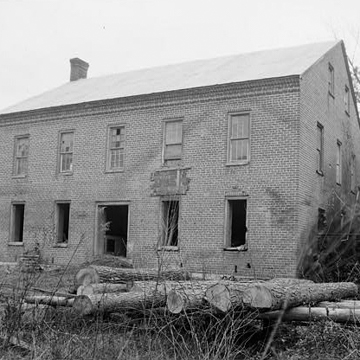Well into the twentieth century, scores of water-powered mills could be found along Alabama’s numerous creeks and streams, and they were often meeting places for locals in an overwhelmingly rural state. Typically, Alabama mills were rudimentary affairs of frame or rough log construction —a far cry from the sturdy brick and stone mills found in the Upper South and across the Middle Atlantic states. Aderholdt’s Mill, three miles south of the town of Jacksonville, is a marked exception. It is solidly built of dark-red brick, embellished by a wide corbelled cornice, and rises two-and-a-half stories from a foundation of rough-hewn local granite. The structure is a testament not only to a pool of exceptionally skilled craftsmen in the area, but also to the mid-nineteenth-century prosperity of this fertile upland piedmont region, with its corn, grain, and cotton crops, nestled below the final spurs of the Appalachians. The area was also blessed with an abundance of swift-flowing waterways conducive to mill construction.
Tradition holds that grist-milling operations began here, on a tributary of the Coosa River known as Little Tallasseehatchee Creek, not long after the native Creek Indians were removed from the surrounding lands in 1832. After the first mill was destroyed by fire, Thomas R. Williams, a settler recently arrived from Georgia, is said to have contracted with Thomas Crutchfield to build the present mill in the late 1830s. Little changed over the ensuing decades, but it became known as Aderholdt’s Mill after 1921, when acquired by James E. Aderholdt and his son. Milling operations continued until 1976.
In January 1935, the Historic American Buildings Survey documented the mill in a series of photographs taken shortly before the great wooden overshot waterwheel was replaced by an undershot turbine, fed by a race from the adjoining pond. At this time, an auxiliary gasoline engine was also installed for occasions when the turbine was inoperative. Motive power was transmitted from the lower level of the mill by an intricate system of wheels and pulleys to the corn and wheat-grinding machinery on the floor above.
Built into a steeply rising hillside, the mill can be entered at either level. A broad, paneled Dutch door opens from the second floor directly onto the outside staging area where sacks of corn and wheat would have been loaded. Though now a private residence, the mill preserves much of its early equipment. In the 1990s, an overshot wheel—manufactured of steel instead of the original wood—was reinstalled at the south gable end of the building.
References
Shell, Mary Mason, “Aderholdt’s Mill,” Calhoun County, Alabama. National Register of Historic Places Inventory-Nomination Form, 1988. National Park Service, U.S. Department of the Interior, Washington, D.C.














